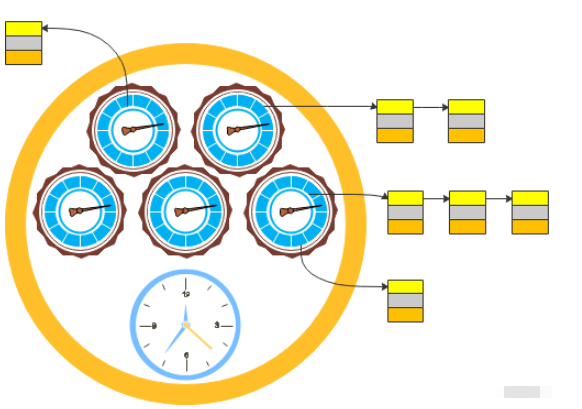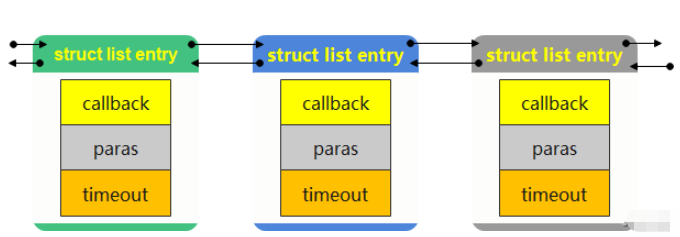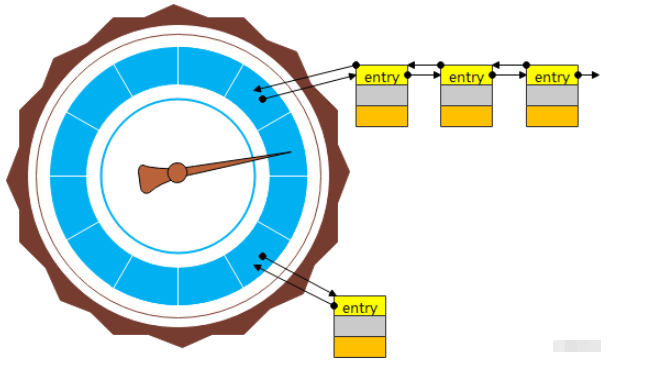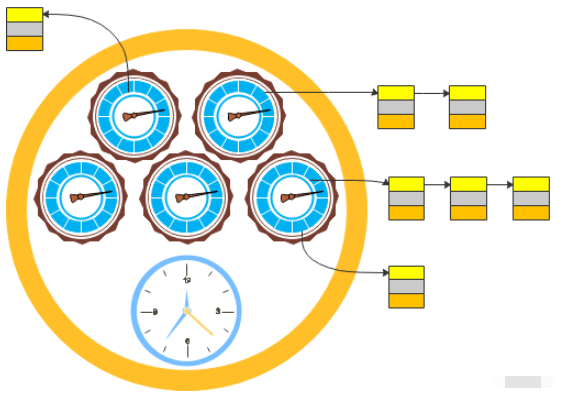您好,登錄后才能下訂單哦!
您好,登錄后才能下訂單哦!
今天小編給大家分享一下C語言如何實現經典多級時間輪定時器的相關知識點,內容詳細,邏輯清晰,相信大部分人都還太了解這方面的知識,所以分享這篇文章給大家參考一下,希望大家閱讀完這篇文章后有所收獲,下面我們一起來了解一下吧。
參考Linux源碼中的實現

上圖是5個時間輪級聯的效果圖。中間的大輪是工作輪,只有在它上的任務才會被執行;其他輪上的任務時間到后遷移到下一級輪上,他們最終都會遷移到工作輪上而被調度執行。
多級時間輪的原理也容易理解:就拿時鐘做說明,秒針轉動一圈分針轉動一格;分針轉動一圈時針轉動一格;同理時間輪也是如此:當低級輪轉動一圈時,高一級輪轉動一格,同時會將高一級輪上的任務重新分配到低級輪上。從而實現了多級輪級聯的效果。
多級時間輪應該至少包括以下內容:
每一級時間輪對象
輪子上指針的位置

關于輪子上指針的位置有一個比較巧妙的辦法:那就是位運算。比如定義一個無符號整型的數:
==通過獲取當前的系統時間便可以通過位操作轉換為時間輪上的時間,通過與實際時間輪上的時間作比較,從而確定時間輪要前進調度的時間,進而操作對應時間輪槽位對應的任務==。
為什么至少需要這兩個成員呢?
定義多級時間輪,首先需要明確的便是級聯的層數,也就是說需要確定有幾個時間輪。
輪子上指針位置,就是當前時間輪運行到的位置,它與真實時間的差便是后續時間輪需要調度執行,它們的差值是時間輪運作起來的驅動力。
多級時間輪對象的定義
//實現5級時間輪 范圍為0~ (2^8 * 2^6 * 2^6 * 2^6 *2^6)=2^32
struct tvec_base
{
unsigned long current_index;
pthread_t thincrejiffies;
pthread_t threadID;
struct tvec_root tv1; /*第一個輪*/
struct tvec tv2; /*第二個輪*/
struct tvec tv3; /*第三個輪*/
struct tvec tv4; /*第四個輪*/
struct tvec tv5; /*第五個輪*/
};我們知道每一個輪子實際上都是一個哈希表,上面我們只是實例化了五個輪子的對象,但是五個輪子具體包含什么,有幾個槽位等等沒有明確(即struct tvec和struct tvec_root)。
#define TVN_BITS 6
#define TVR_BITS 8
#define TVN_SIZE (1<<TVN_BITS)
#define TVR_SIZE (1<<TVR_BITS)
struct tvec {
struct list_head vec[TVN_SIZE];/*64個格子*/
};
struct tvec_root{
struct list_head vec[TVR_SIZE];/*256個格子*/
};此外,每一個時間輪都是哈希表,因此它的類型應該至少包含兩個指針域來實現雙向鏈表的功能。這里我們為了方便使用通用的struct list_head的雙向鏈表結構。

定時器的主要工作是為了在未來的特定時間完成某項任務,而這個任務經常包含以下內容:
任務的處理邏輯(回調函數)
任務的參數
雙向鏈表節點
到時時間
定時任務對象的定義
typedef void (*timeouthandle)(unsigned long );
struct timer_list{
struct list_head entry; //將時間連接成鏈表
unsigned long expires; //超時時間
void (*function)(unsigned long); //超時后的處理函數
unsigned long data; //處理函數的參數
struct tvec_base *base; //指向時間輪
};在時間輪上的效果圖:

在時間輪上我們采用雙向鏈表的數據類型。采用雙向鏈表的除了操作上比單鏈表復雜,多占一個指針域外沒有其他不可接收的問題。而多占一個指針域在今天大內存的時代明顯不是什么問題。至于雙向鏈表操作的復雜性,我們可以通過使用通用的struct list結構來解決,因為雙向鏈表有眾多的標準操作函數,我們可以通過直接引用list.h頭文件來使用他們提供的接口。
struct list可以說是一個萬能的雙向鏈表操作框架,我們只需要在自定義的結構中定義一個struct list對象即可使用它的標準操作接口。同時它還提供了一個類似container_of的接口,在應用層一般叫做list_entry,因此我們可以很方便的通過struct list成員找到自定義的結構體的起始地址。
關于應用層的log.h, 我將在下面的代碼中附上該文件。如果需要內核層的實現,可以直接從linux源碼中獲取。
多級時間輪效果圖:

提到雙向鏈表,很多的源碼工程中都會實現一系列的統一的雙向鏈表操作函數。它們為雙向鏈表封裝了統計的接口,使用者只需要在自定義的結構中添加一個struct list_head結構,然后調用它們提供的接口,便可以完成雙向鏈表的所有操作。這些操作一般都在list.h的頭文件中實現。Linux源碼中也有實現(內核態的實現)。他們實現的方式基本完全一樣,只是實現的接口數量和功能上稍有差別。可以說這個==list.h文件是學習操作雙向鏈表的不二選擇==,它幾乎實現了所有的操作:增、刪、改、查、遍歷、替換、清空等等。這里我拼湊了一個源碼中的log.h函數,終于湊夠了多級時間輪中使用到的接口(原來的博主沒有提供list.h文件,只能自己去東拼西湊)。
#if !defined(_BLKID_LIST_H) && !defined(LIST_HEAD)
#define _BLKID_LIST_H
#ifdef __cplusplus
extern "C" {
#endif
/*
* Simple doubly linked list implementation.
*
* Some of the internal functions ("__xxx") are useful when
* manipulating whole lists rather than single entries, as
* sometimes we already know the next/prev entries and we can
* generate better code by using them directly rather than
* using the generic single-entry routines.
*/
struct list_head {
struct list_head *next, *prev;
};
#define LIST_HEAD_INIT(name) { &(name), &(name) }
#define LIST_HEAD(name)
struct list_head name = LIST_HEAD_INIT(name)
#define INIT_LIST_HEAD(ptr) do {
(ptr)->next = (ptr); (ptr)->prev = (ptr);
} while (0)
static inline void
__list_add(struct list_head *entry,
struct list_head *prev, struct list_head *next)
{
next->prev = entry;
entry->next = next;
entry->prev = prev;
prev->next = entry;
}
/**
* Insert a new element after the given list head. The new element does not
* need to be initialised as empty list.
* The list changes from:
* head → some element → ...
* to
* head → new element → older element → ...
*
* Example:
* struct foo *newfoo = malloc(...);
* list_add(&newfoo->entry, &bar->list_of_foos);
*
* @param entry The new element to prepend to the list.
* @param head The existing list.
*/
static inline void
list_add(struct list_head *entry, struct list_head *head)
{
__list_add(entry, head, head->next);
}
/**
* Append a new element to the end of the list given with this list head.
*
* The list changes from:
* head → some element → ... → lastelement
* to
* head → some element → ... → lastelement → new element
*
* Example:
* struct foo *newfoo = malloc(...);
* list_add_tail(&newfoo->entry, &bar->list_of_foos);
*
* @param entry The new element to prepend to the list.
* @param head The existing list.
*/
static inline void
list_add_tail(struct list_head *entry, struct list_head *head)
{
__list_add(entry, head->prev, head);
}
static inline void
__list_del(struct list_head *prev, struct list_head *next)
{
next->prev = prev;
prev->next = next;
}
/**
* Remove the element from the list it is in. Using this function will reset
* the pointers to/from this element so it is removed from the list. It does
* NOT free the element itself or manipulate it otherwise.
*
* Using list_del on a pure list head (like in the example at the top of
* this file) will NOT remove the first element from
* the list but rather reset the list as empty list.
*
* Example:
* list_del(&foo->entry);
*
* @param entry The element to remove.
*/
static inline void
list_del(struct list_head *entry)
{
__list_del(entry->prev, entry->next);
}
static inline void
list_del_init(struct list_head *entry)
{
__list_del(entry->prev, entry->next);
INIT_LIST_HEAD(entry);
}
static inline void list_move_tail(struct list_head *list,
struct list_head *head)
{
__list_del(list->prev, list->next);
list_add_tail(list, head);
}
/**
* Check if the list is empty.
*
* Example:
* list_empty(&bar->list_of_foos);
*
* @return True if the list contains one or more elements or False otherwise.
*/
static inline int
list_empty(struct list_head *head)
{
return head->next == head;
}
/**
* list_replace - replace old entry by new one
* @old : the element to be replaced
* @new : the new element to insert
*
* If @old was empty, it will be overwritten.
*/
static inline void list_replace(struct list_head *old,
struct list_head *new)
{
new->next = old->next;
new->next->prev = new;
new->prev = old->prev;
new->prev->next = new;
}
/**
* Retrieve the first list entry for the given list pointer.
*
* Example:
* struct foo *first;
* first = list_first_entry(&bar->list_of_foos, struct foo, list_of_foos);
*
* @param ptr The list head
* @param type Data type of the list element to retrieve
* @param member Member name of the struct list_head field in the list element.
* @return A pointer to the first list element.
*/
#define list_first_entry(ptr, type, member)
list_entry((ptr)->next, type, member)
static inline void list_replace_init(struct list_head *old,
struct list_head *new)
{
list_replace(old, new);
INIT_LIST_HEAD(old);
}
/**
* list_entry - get the struct for this entry
* @ptr: the &struct list_head pointer.
* @type: the type of the struct this is embedded in.
* @member: the name of the list_struct within the struct.
*/
#define list_entry(ptr, type, member)
((type *)((char *)(ptr)-(unsigned long)(&((type *)0)->member)))
/**
* list_for_each - iterate over elements in a list
* @pos: the &struct list_head to use as a loop counter.
* @head: the head for your list.
*/
#define list_for_each(pos, head)
for (pos = (head)->next; pos != (head); pos = pos->next)
/**
* list_for_each_safe - iterate over elements in a list, but don"t dereference
* pos after the body is done (in case it is freed)
* @pos: the &struct list_head to use as a loop counter.
* @pnext: the &struct list_head to use as a pointer to the next item.
* @head: the head for your list (not included in iteration).
*/
#define list_for_each_safe(pos, pnext, head)
for (pos = (head)->next, pnext = pos->next; pos != (head);
pos = pnext, pnext = pos->next)
#ifdef __cplusplus
}
#endif
#endif /* _BLKID_LIST_H */這里面一般會用到一個重要實現:==container_of==, 它的原理如果不清楚的話,可以閱讀另一篇專門介紹該函數的博文:container of()函數簡介
這個頭文件實際上不是必須的,我只是用它來添加調試信息(代碼中的errlog(), log()都是log.h中的宏函數)。它的效果是給打印的信息加上顏色,效果如下:

log.h的代碼如下:
#ifndef _LOG_h_
#define _LOG_h_
#include <stdio.h>
#define COL(x) "33[;" #x "m"
#define RED COL(31)
#define GREEN COL(32)
#define YELLOW COL(33)
#define BLUE COL(34)
#define MAGENTA COL(35)
#define CYAN COL(36)
#define WHITE COL(0)
#define GRAY "33[0m"
#define errlog(fmt, arg...) do{
printf(RED"[#ERROR: Toeny Sun:"GRAY YELLOW" %s:%d]:"GRAY WHITE fmt GRAY, __func__, __LINE__, ##arg);
}while(0)
#define log(fmt, arg...) do{
printf(WHITE"[#DEBUG: Toeny Sun: "GRAY YELLOW"%s:%d]:"GRAY WHITE fmt GRAY, __func__, __LINE__, ##arg);
}while(0)
#endif/*
*毫秒定時器 采用多級時間輪方式 借鑒linux內核中的實現
*支持的范圍為1 ~ 2^32 毫秒(大約有49天)
*若設置的定時器超過最大值 則按最大值設置定時器
**/
#include <stdio.h>
#include <stdlib.h>
#include <string.h>
#include <unistd.h>
#include <pthread.h>
#include <sys/time.h>
#include "list.h"
#include "log.h"
#define TVN_BITS 6
#define TVR_BITS 8
#define TVN_SIZE (1<<TVN_BITS)
#define TVR_SIZE (1<<TVR_BITS)
#define TVN_MASK (TVN_SIZE - 1)
#define TVR_MASK (TVR_SIZE - 1)
#define SEC_VALUE 0
#define USEC_VALUE 2000
struct tvec_base;
#define INDEX(N) ((ba->current_index >> (TVR_BITS + (N) * TVN_BITS)) & TVN_MASK)
typedef void (*timeouthandle)(unsigned long );
struct timer_list{
struct list_head entry; //將時間連接成鏈表
unsigned long expires; //超時時間
void (*function)(unsigned long); //超時后的處理函數
unsigned long data; //處理函數的參數
struct tvec_base *base; //指向時間輪
};
struct tvec {
struct list_head vec[TVN_SIZE];
};
struct tvec_root{
struct list_head vec[TVR_SIZE];
};
//實現5級時間輪 范圍為0~ (2^8 * 2^6 * 2^6 * 2^6 *2^6)=2^32
struct tvec_base
{
unsigned long current_index;
pthread_t thincrejiffies;
pthread_t threadID;
struct tvec_root tv1; /*第一個輪*/
struct tvec tv2; /*第二個輪*/
struct tvec tv3; /*第三個輪*/
struct tvec tv4; /*第四個輪*/
struct tvec tv5; /*第五個輪*/
};
static void internal_add_timer(struct tvec_base *base, struct timer_list *timer)
{
struct list_head *vec;
unsigned long expires = timer->expires;
unsigned long idx = expires - base->current_index;
#if 1
if( (signed long)idx < 0 ) /*這里是沒有辦法區分出是過時還是超長定時的吧?*/
{
vec = base->tv1.vec + (base->current_index & TVR_MASK);/*放到第一個輪的當前槽*/
}
else if ( idx < TVR_SIZE ) /*第一個輪*/
{
int i = expires & TVR_MASK;
vec = base->tv1.vec + i;
}
else if( idx < 1 << (TVR_BITS + TVN_BITS) )/*第二個輪*/
{
int i = (expires >> TVR_BITS) & TVN_MASK;
vec = base->tv2.vec + i;
}
else if( idx < 1 << (TVR_BITS + 2 * TVN_BITS) )/*第三個輪*/
{
int i = (expires >> (TVR_BITS + TVN_BITS)) & TVN_MASK;
vec = base->tv3.vec + i;
}
else if( idx < 1 << (TVR_BITS + 3 * TVN_BITS) )/*第四個輪*/
{
int i = (expires >> (TVR_BITS + 2 * TVN_BITS)) & TVN_MASK;
vec = base->tv4.vec + i;
}
else /*第五個輪*/
{
int i;
if (idx > 0xffffffffUL)
{
idx = 0xffffffffUL;
expires = idx + base->current_index;
}
i = (expires >> (TVR_BITS + 3 * TVN_BITS)) & TVN_MASK;
vec = base->tv5.vec + i;
}
#else
/*上面可以優化吧*/;
#endif
list_add_tail(&timer->entry, vec);
}
static inline void detach_timer(struct timer_list *timer)
{
struct list_head *entry = &timer->entry;
__list_del(entry->prev, entry->next);
entry->next = NULL;
entry->prev = NULL;
}
static int __mod_timer(struct timer_list *timer, unsigned long expires)
{
if(NULL != timer->entry.next)
detach_timer(timer);
internal_add_timer(timer->base, timer);
return 0;
}
//修改定時器的超時時間外部接口
int mod_timer(void *ptimer, unsigned long expires)
{
struct timer_list *timer = (struct timer_list *)ptimer;
struct tvec_base *base;
base = timer->base;
if(NULL == base)
return -1;
expires = expires + base->current_index;
if(timer->entry.next != NULL && timer->expires == expires)
return 0;
if( NULL == timer->function )
{
errlog("timer"s timeout function is null
");
return -1;
}
timer->expires = expires;
return __mod_timer(timer,expires);
}
//添加一個定時器
static void __ti_add_timer(struct timer_list *timer)
{
if( NULL != timer->entry.next )
{
errlog("timer is already exist
");
return;
}
mod_timer(timer, timer->expires);
}
/*添加一個定時器 外部接口
*返回定時器
*/
void* ti_add_timer(void *ptimewheel, unsigned long expires,timeouthandle phandle, unsigned long arg)
{
struct timer_list *ptimer;
ptimer = (struct timer_list *)malloc( sizeof(struct timer_list) );
if(NULL == ptimer)
return NULL;
bzero( ptimer,sizeof(struct timer_list) );
ptimer->entry.next = NULL;
ptimer->base = (struct tvec_base *)ptimewheel;
ptimer->expires = expires;
ptimer->function = phandle;
ptimer->data = arg;
__ti_add_timer(ptimer);
return ptimer;
}
/*
*刪除一個定時器 外部接口
*
* */
void ti_del_timer(void *p)
{
struct timer_list *ptimer =(struct timer_list*)p;
if(NULL == ptimer)
return;
if(NULL != ptimer->entry.next)
detach_timer(ptimer);
free(ptimer);
}
/*時間輪級聯*/
static int cascade(struct tvec_base *base, struct tvec *tv, int index)
{
struct list_head *pos,*tmp;
struct timer_list *timer;
struct list_head tv_list;
/*將tv[index]槽位上的所有任務轉移給tv_list,然后清空tv[index]*/
list_replace_init(tv->vec + index, &tv_list);/*用tv_list替換tv->vec + index*/
list_for_each_safe(pos, tmp, &tv_list)/*遍歷tv_list雙向鏈表,將任務重新添加到時間輪*/
{
timer = list_entry(pos,struct timer_list,entry);/*struct timer_list中成員entry的地址是pos, 獲取struct timer_list的首地址*/
internal_add_timer(base, timer);
}
return index;
}
static void *deal_function_timeout(void *base)
{
struct timer_list *timer;
int ret;
struct timeval tv;
struct tvec_base *ba = (struct tvec_base *)base;
for(;;)
{
gettimeofday(&tv, NULL);
while( ba->current_index <= (tv.tv_sec*1000 + tv.tv_usec/1000) )/*單位:ms*/
{
struct list_head work_list;
int index = ba->current_index & TVR_MASK;/*獲取第一個輪上的指針位置*/
struct list_head *head = &work_list;
/*指針指向0槽時,級聯輪需要更新任務列表*/
if(!index && (!cascade(ba, &ba->tv2, INDEX(0))) &&( !cascade(ba, &ba->tv3, INDEX(1))) && (!cascade(ba, &ba->tv4, INDEX(2))) )
cascade(ba, &ba->tv5, INDEX(3));
ba->current_index ++;
list_replace_init(ba->tv1.vec + index, &work_list);
while(!list_empty(head))
{
void (*fn)(unsigned long);
unsigned long data;
timer = list_first_entry(head, struct timer_list, entry);
fn = timer->function;
data = timer->data;
detach_timer(timer);
(*fn)(data);
}
}
}
}
static void init_tvr_list(struct tvec_root * tvr)
{
int i;
for( i = 0; i<TVR_SIZE; i++ )
INIT_LIST_HEAD(&tvr->vec[i]);
}
static void init_tvn_list(struct tvec * tvn)
{
int i;
for( i = 0; i<TVN_SIZE; i++ )
INIT_LIST_HEAD(&tvn->vec[i]);
}
//創建時間輪 外部接口
void *ti_timewheel_create(void )
{
struct tvec_base *base;
int ret = 0;
struct timeval tv;
base = (struct tvec_base *) malloc( sizeof(struct tvec_base) );
if( NULL==base )
return NULL;
bzero( base,sizeof(struct tvec_base) );
init_tvr_list(&base->tv1);
init_tvn_list(&base->tv2);
init_tvn_list(&base->tv3);
init_tvn_list(&base->tv4);
init_tvn_list(&base->tv5);
gettimeofday(&tv, NULL);
base->current_index = tv.tv_sec*1000 + tv.tv_usec/1000;/*當前時間毫秒數*/
if( 0 != pthread_create(&base->threadID,NULL,deal_function_timeout,base) )
{
free(base);
return NULL;
}
return base;
}
static void ti_release_tvr(struct tvec_root *pvr)
{
int i;
struct list_head *pos,*tmp;
struct timer_list *pen;
for(i = 0; i < TVR_SIZE; i++)
{
list_for_each_safe(pos,tmp,&pvr->vec[i])
{
pen = list_entry(pos,struct timer_list, entry);
list_del(pos);
free(pen);
}
}
}
static void ti_release_tvn(struct tvec *pvn)
{
int i;
struct list_head *pos,*tmp;
struct timer_list *pen;
for(i = 0; i < TVN_SIZE; i++)
{
list_for_each_safe(pos,tmp,&pvn->vec[i])
{
pen = list_entry(pos,struct timer_list, entry);
list_del(pos);
free(pen);
}
}
}
/*
*釋放時間輪 外部接口
* */
void ti_timewheel_release(void * pwheel)
{
struct tvec_base *base = (struct tvec_base *)pwheel;
if(NULL == base)
return;
ti_release_tvr(&base->tv1);
ti_release_tvn(&base->tv2);
ti_release_tvn(&base->tv3);
ti_release_tvn(&base->tv4);
ti_release_tvn(&base->tv5);
free(pwheel);
}
/************demo****************/
struct request_para{
void *timer;
int val;
};
void mytimer(unsigned long arg)
{
struct request_para *para = (struct request_para *)arg;
log("%d
",para->val);
mod_timer(para->timer,3000); //進行再次啟動定時器
sleep(10);/*定時器依然被阻塞*/
//定時器資源的釋放是在這里完成的
//ti_del_timer(para->timer);
}
int main(int argc,char *argv[])
{
void *pwheel = NULL;
void *timer = NULL;
struct request_para *para;
para = (struct request_para *)malloc( sizeof(struct request_para) );
if(NULL == para)
return 0;
bzero(para,sizeof(struct request_para));
//創建一個時間輪
pwheel = ti_timewheel_create();
if(NULL == pwheel)
return -1;
//添加一個定時器
para->val = 100;
para->timer = ti_add_timer(pwheel, 3000, &mytimer, (unsigned long)para);
while(1)
{
sleep(2);
}
//釋放時間輪
ti_timewheel_release(pwheel);
return 0;
}toney@ubantu:/mnt/hgfs/em嵌入式學習記錄/4. timerwheel/2. 多級時間輪$ ls a.out list.h log.h mutiTimeWheel.c toney@ubantu:/mnt/hgfs/em嵌入式學習記錄/4. timerwheel/2. 多級時間輪$ gcc mutiTimeWheel.c -lpthread toney@ubantu:/mnt/hgfs/em嵌入式學習記錄/4. timerwheel/2. 多級時間輪$ ./a.out [#DEBUG: Toeny Sun: mytimer:370]:100 [#DEBUG: Toeny Sun: mytimer:370]:100 [#DEBUG: Toeny Sun: mytimer:370]:100 [#DEBUG: Toeny Sun: mytimer:370]:100 [#DEBUG: Toeny Sun: mytimer:370]:100 [#DEBUG: Toeny Sun: mytimer:370]:100 [#DEBUG: Toeny Sun: mytimer:370]:100 [#DEBUG: Toeny Sun: mytimer:370]:100 [#DEBUG: Toeny Sun: mytimer:370]:100 [#DEBUG: Toeny Sun: mytimer:370]:100 [#DEBUG: Toeny Sun: mytimer:370]:100 [#DEBUG: Toeny Sun: mytimer:370]:100 [#DEBUG: Toeny Sun: mytimer:370]:100 [#DEBUG: Toeny Sun: mytimer:370]:100 [#DEBUG: Toeny Sun: mytimer:370]:100 [#DEBUG: Toeny Sun: mytimer:370]:100 [#DEBUG: Toeny Sun: mytimer:370]:100 [#DEBUG: Toeny Sun: mytimer:370]:100 [#DEBUG: Toeny Sun: mytimer:370]:100 [#DEBUG: Toeny Sun: mytimer:370]:100 [#DEBUG: Toeny Sun: mytimer:370]:100 [#DEBUG: Toeny Sun: mytimer:370]:100 [#DEBUG: Toeny Sun: mytimer:370]:100 [#DEBUG: Toeny Sun: mytimer:370]:100 [#DEBUG: Toeny Sun: mytimer:370]:100 [#DEBUG: Toeny Sun: mytimer:370]:100 [#DEBUG: Toeny Sun: mytimer:370]:100 [#DEBUG: Toeny Sun: mytimer:370]:100
從結果可以看出:如果添加的定時任務是比較耗時的操作,那么后續的任務也會被阻塞,可能一直到超時,甚至一直阻塞下去,這個取決于當前任務是否耗時。
以上就是“C語言如何實現經典多級時間輪定時器”這篇文章的所有內容,感謝各位的閱讀!相信大家閱讀完這篇文章都有很大的收獲,小編每天都會為大家更新不同的知識,如果還想學習更多的知識,請關注億速云行業資訊頻道。
免責聲明:本站發布的內容(圖片、視頻和文字)以原創、轉載和分享為主,文章觀點不代表本網站立場,如果涉及侵權請聯系站長郵箱:is@yisu.com進行舉報,并提供相關證據,一經查實,將立刻刪除涉嫌侵權內容。